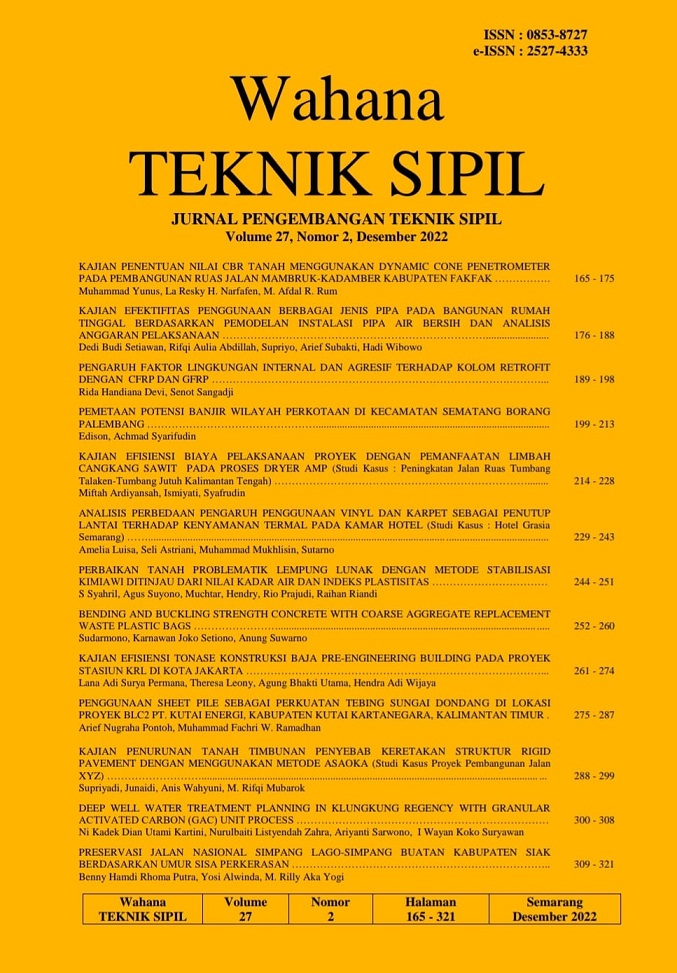KAJIAN PENURUNAN TANAH TIMBUNAN PENYEBAB KERETAKAN STRUKTUR RIGID PAVEMENT DENGAN MENGGUNAKAN METODE ASAOKA (Studi Kasus Proyek Pembangunan Jalan XYZ)
DOI:
https://doi.org/10.32497/wahanats.v27i2.4149Keywords:
keretakan, rigid pavement, penurunan tanahAbstract
Rigid pavement work on the XYZ Road Construction Project experienced a problem,
namely the occurrence of cracks in the rigid pavement structure above the box
culverts under which soil improvement was carried out using embankment soil. The
purpose of this study is to analyze the factors that cause settlement of the
embankment that causes the rift of the rigid pavement structure on box culverts built
on embankment soil so that the results can be used as a reference for handling or
repairing rigid pavement work on box culverts with a structure piled up soil in
subsequent segments. From the results of the analysis it can be seen that the process
of casting rigid pavement was carried out at two points, namely Point 1 and Point 2
where after casting the rigid pavement, the subgrade beneath it still experienced a
decrease of 10 mm and 6 mm. This decline occurred for up to 3 months and caused
cracks in the rigid pavement structure above it. This is due to the difference in
settlement of the box culvert which was initially assumed not to have decreased
again with the surrounding embankment which was still experiencing settlement. In
addition, the results of the analysis show that the rigid pavement design uses a
single reinforcement so that the capacity of the concrete (Mu) is less than the weight
of the concrete itself which causes the concrete to crack.
References
Asaoka, A., 1978, Observational Procedure of Settlement Predictions, Journal of Soils and Foundations, Vol. 18, No. 4, pp. 87-101.
Cascone, Ernesto and Giovanni Biondi, 2013, A Case Study on Soil Settlements Induced by Preloading and Vertical Drains, Jurnal of Geotextiles and Geomembranes, Vol. 38 (2013) pp. 51-67.
Dhakal, Nirmal, Mostafa A. Elseifi, Zhongjie Zhang, 2016, Mitigation strategies for reflection cracking in rehabilitated pavements ”“ A synthesis, International Journal of Pavement Research and Technology, Vol. 9 (2016) pp. 228”“239.
Das, Braja M., 1995, Mekanika Tanah: Prinsip-Prinsip Rekayasa Geoteknik Jilid 1. Diterjemahkan oleh Noor Endah dan Indrasurya B.M., Surabaya: Erlangga.
Efendi, Aflah Baihaqi, Indra Nurtjahtjaningtyas & Luthfi Amri Wicaksono, 2019, Evaluasi Penurunan Akhir Tanah Di Lapangan Menggunakan Metode Observasional : Asaoka Dan Hiperbolik Pada Proyek PPKA Seksi 2 Palembang Sumatra Selatan. Jurnal Rekayasa Sipil dan Lingkungan Vol. 3, No. 1, Fakultas Teknik, Universitas Jember.
Hardiyatmo, Harry C., 2010, Mekanika Tanah 2. Yogyakarta: Gadjah Mada University Press.
Kuswanda, Wahyu P., 2016, Perbaikan Tanah Lempung Lunak Metoda Preloading Pada Pembangunan Infrastruktur Transportasi Di Pulau Kalimantan. Prosding Seminar Nasional Geoteknik, Teknik Sipil, Universitas Lambung Mangkurat, Banjarmasin.
Sugiyono, 2012, Memahami Penelitian Kualitatif. ALFABETA, Bandung.
Susiazti, Heny, Masayu Widiastuti & Rusfiana Widyanti, 2020, Analisis Penurunan Konsolidasi Metode Preloading Dan Prefabricated Vertical Drain (PVD). Jurnal Teknologi Sipil Vol. 4, No. 1, Fakultas Teknik, Universitas Mulawarman, Samarinda.
Tan, Siew Ann and Soon Hoe Chew, 1996, Comparison of the Hyperbolic and Asaoka Observational Method of Monitoring Consolidation with Vertical Drains, Journal of Soils and Foundations Vol. 36, No. 3, pp. 31-42, Sept. 1996.
Xiao, Danny X., and Zhong Wu, 2018, Longitudinal Cracking of Jointed Plain Concrete Pavements in Louisiana: Field Investigation and Numerical Simulation, International Journal of Pavement Research and Technology, Vol. 11 (2018) pp. 417”“426
Downloads
Published
Issue
Section
License
Authors who publish with this journal agree to the following terms:Authors retain copyright and grant the journal right of first publication with the work simultaneously licensed under a Creative Commons Attribution License that allows others to share the work with an acknowledgement of the work's authorship and initial publication in this journal.
Authors are able to enter into separate, additional contractual arrangements for the non-exclusive distribution of the journal's published version of the work (e.g., post it to an institutional repository or publish it in a book), with an acknowledgement of its initial publication in this journal.
Authors are permitted and encouraged to post their work online (e.g., in institutional repositories or on their website) prior to and during the submission process, as it can lead to productive exchanges, as well as earlier and greater citation of published work (See The Effect of Open Access).






